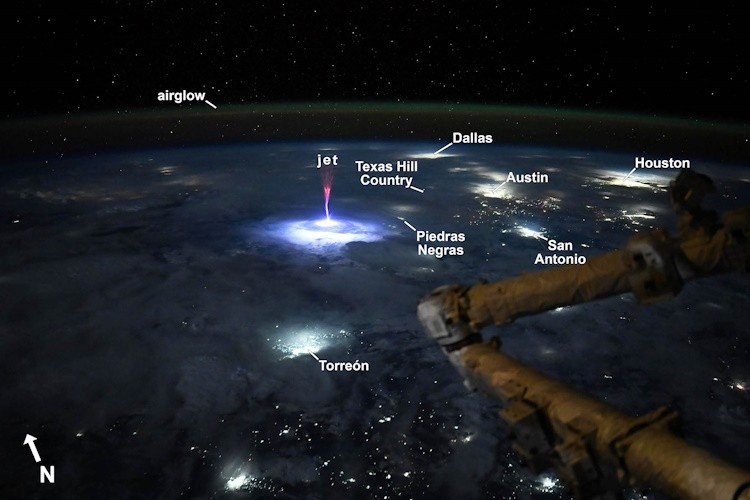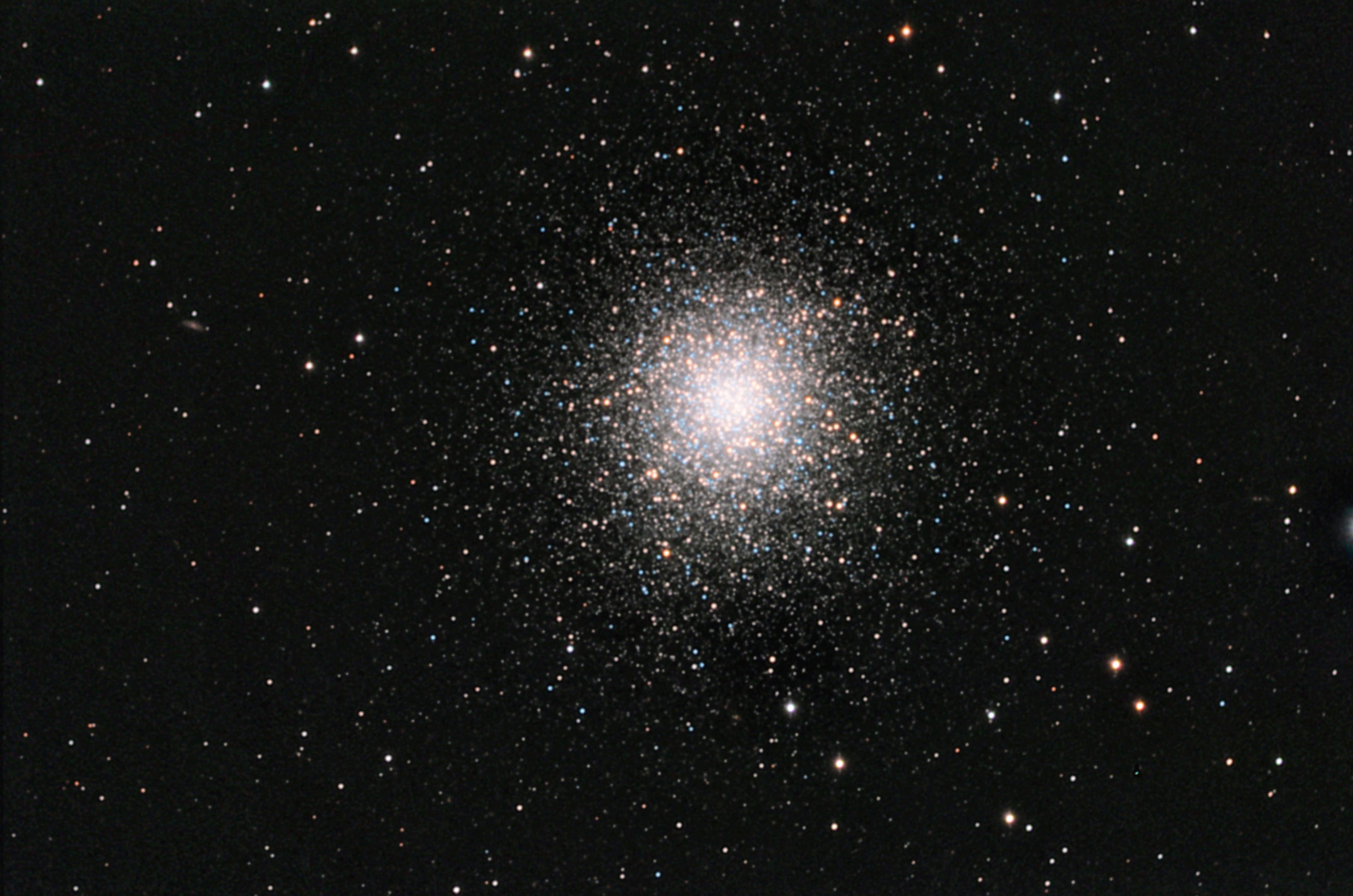Researchers Use the ISS to Study Rare Transient Luminous Events in the Upper Atmosphere

Gigantic Jet Event captured from the International Space Station. These are powerful electrical discharges that extends from the top of a thunderstorm into the upper atmosphere. Gigantic Jets appear when the turbulent conditions at towering thunderstorms enable lightning to escape from the tops of thunderstorm, propagating upwards toward space. They create an electrical bridge between the tops of the clouds (about 20 km) and the upper atmosphere (about 100 km), depositing a significant amount of electrical charge in the process. (Image Credit: NASA Astronaut Nichole Ayers)
Researchers Use the ISS to Study Rare Transient Luminous Events in the Upper Atmosphere
Scientists are using instruments on the International Space Station to study phenomena in Earth’s ionosphere or upper atmosphere including thunderstorms, lightning, and the more rare Transient Luminous Events (TLEs). TLEs take many forms, including blue jets (discharges that grow upward into the stratosphere from cloud tops) and colorful bursts of energy above storms called Stratospheric/Mesospheric Perturbations resulting from Intense Thunderstorm Electrification or SPRITES.
TLEs can disrupt communication systems on the ground and pose a threat to aircraft and spacecraft. Understanding these phenomena could also improve atmospheric models and weather predictions. Because these events occur well above the altitudes of normal lightning and storm clouds, they are difficult to observe from the ground, but are more readily observed from space.
ASIM, an investigation from ESA (European Space Agency), uses a monitor on the exterior of the space station to collect data on TLEs. These data are providing insights into how thunderstorms affect Earth’s atmosphere and helping to improve atmospheric models used for weather and climate predictions.
Gigantic jets are a powerful type of electrical discharge that extends from the top of a thunderstorm into the upper atmosphere. They are typically observed by chance — often spotted by airline passengers or captured unintentionally by ground-based cameras aimed at other phenomena. Gigantic jets appear when the turbulent conditions at towering thunderstorm tops allow for lightning to escape the thunderstorm, propagating upwards toward space. They create an electrical bridge between the tops of the clouds (~20 km) and the upper atmosphere (~100 km), depositing a significant amount of electrical charge.
Sprites
Sprites, on the other hand, are one of the most commonly observed types of TLEs — brief, colorful flashes of light that occur high above thunderstorms in the mesosphere, around 50 miles (80 kilometers) above Earth’s surface. Unlike gigantic jets, which burst upward directly from thundercloud tops, sprites form independently, much higher in the atmosphere, following powerful lightning strikes. They usually appear as a reddish glow with intricate shapes resembling jellyfish, columns, or carrots and can span tens of kilometers across. Sprites may also be accompanied or preceded by other TLEs, such as Halos and ELVEs (Emissions of Light and Very Low Frequency perturbations due to Electromagnetic Pulse Sources), making them part of a larger and visually spectacular suite of high-altitude electrical activity. The world of Transient Luminous Events is a hidden zoo of atmospheric activity playing out above the storms.
ELVES and Coronas
A study based on ASIM data confirmed that lightning-like discharges at the tops of thunderstorms can create another type of TLE, massive glowing rings in the upper atmosphere known as Emissions of Light and VLF Perturbations from EMP events, or ELVES. This experiment showed that these discharges influence the ionosphere and helped scientists learn more about Earth and space weather.
ASIM-based research also described the physical properties of different types of corona discharges in thunderstorm clouds. Corona discharges are linked to powerful but short-lived electrical bursts near the tops of clouds. The data provide a reference to support further investigation into the mechanisms behind these discharges and their role in the initiation of lightning, an important problem in lightning physics.
Other researchers used ASIM measurements along with ground-based electric field measurements to determine the height of a blue discharge from a thundercloud.
ESA and JAXA
The ESA Thor-Davis investigation evaluated use of a special camera to photograph high-altitude thunderstorms through the windows of the space station’s cupola. The camera can observe thunderstorm electrical activity at up to 100,000 frames per second and could be a useful tool for space-based observation of severe electrical storms and other applications.
The JAXA (Japan Aerospace Exploration Agency) investigation Light-1 CubeSat used detectors integrated into a compact satellite to observe terrestrial gamma-ray flashes in the upper atmosphere. These high intensity, energetic events can expose aircraft, aircraft electronics, and passengers to excessive radiation. Researchers are planning to compare data collected from the mission with ground-based observations to provide more comprehensive maps of lightning and thunderstorms in the atmosphere. Small satellite detectors could cost less and be manufactured in less time than other approaches.
For more information:
https://www.nasa.gov/missions/station/iss-research/studying-storms-from-space-station/
Astromart News Archives:
https://www.astromart.com/news/search?category_id=3&q=.
This is my personal deep sky observing list. I use it to line up my DSO targets on any particular night:
Check out some of my favorite Words of Wisdom:
https://www.astromart.com/news/show/words-of-wisdom-some-are-deep-others-not-so-much
https://www.astromart.com/news/show/words-of-wisdom-my-favorite-proverbs-from-around-the-world
Do you enjoy reading these postings?
Then click here and buy the Astromart crew a cup of coffee (and maybe even some donuts):
https://www.astromart.com/support-options
Funding Member
Sponsors
- Desert Sky Astro Products
- Rouz Astro
- FocusKnobs
- ASTROPHOTOGRAPHY BY MARTIN PUGH
- BW
- AstroMart LLC
- Matsumoto Company
- Bob's Knobs
- astronomy-shoppe
- RemoteSkies.net
- Astromart Customer Service
- Anacortes Telescope
- APM-Telescopes
- Waite Research
- OMI OPTICS USA LLC
- SellTelescopes.com
- BBLABS LLC
View all sponsors



